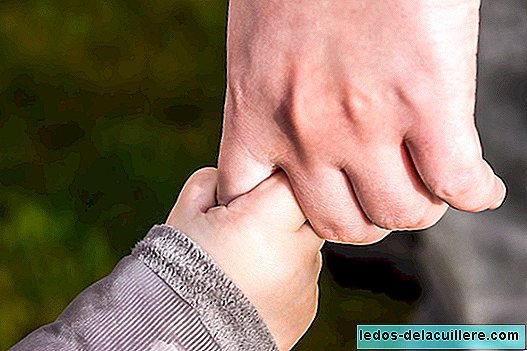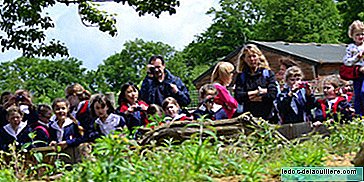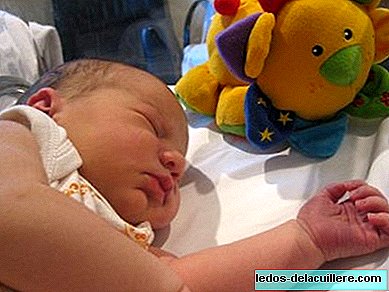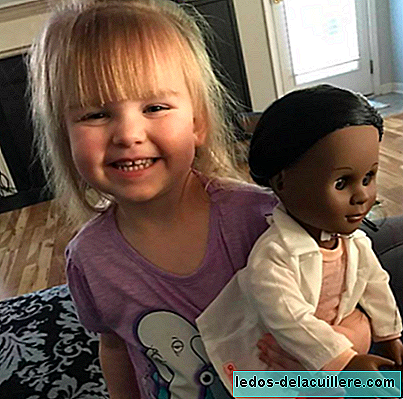I often talk about the adoption of our children. It is not that I am telling it to the four winds but I imagine that, like everything that we are passionate about or live as a great joy, it ends up emerging in one way or another. One of the last times, it came out on the occasion of the names we put to our children, I commented that mine already came with a name and we did not change them. We were able to do it, and in fact it is very lawful, but at the time we lived it as a way of loving them as they were, as they came, with what they came.
In conversations like this, I observe that adoption is something that generates curiosity, interest, emotion and even admiration. Some call you brave, others a good person, but there's nothing like that. Just a deep desire to be parents. And experts say that it has to be. In my case, my three children have been adopted in Spain. From my experience this article was born that I share in case someone is in a situation similar to ours and I could help them.
First steps and procedures to adopt a child
When you decide to explore the route of adoption, the first thing is to telephone the child protection entity of the autonomous community where you reside where you will be summoned, together with other interested parties, to a first informative meeting.
Informational meeting
The technicians, from the Community of Madrid in our case, were very clear from the beginning: Adoption is not an altruistic or goodwill option, that's what NGOs are for. The adoption is only for those who want to be parents (with all that that entails and for a lifetime) and not of any son, but of the son of others who has been abandoned. This, together with the amount of paperwork, the years of waiting or the uncertainty about what will come, seems to invite rather a withdrawal, but the one who wishes to be a father is willing to do everything for his children, so it is essential that This is the only motivation.
Open file
If you decide to move on, you must open your file, this is to present your request accompanied by a good handful of documents (as almost everything is scanned, it is enough to authorize the consultation to the Administration) that includes from birth certificates, to certificates that declare that you are free of criminal offenses, going through medical certificates, registration, income ...
Training days
Once the file is registered, you are summoned to training days with other families where the processes, the countries, the trips are explained, the children, situations, the encounter, the waiting are talked about ... And the family members can raise their doubts, ask questions to express fears ...
Psychosocial assessment
Then will come the psychosocial assessment: a battery of tests and interviews with psychologists that make us review our past and explore our present (activities, environments, family relationships, friends, hobbies ...) and, with all this, express our motivations, desires, frustrations and also our expectations about The son that will come. Both phases, training and psychosocial study, have the same objective: to help us discover if we are in the right place, if the way of adoption, as it really is, wonderful but with unknowns, is the right way to form our family.
It is important to discover it here, and get out of the car in time if I see that I am not going to feel the mother of a child who does not have skin or eyes like mine. Or if I think that I will not be able to bear that my family does not accept a grandson, a nephew, that does not come from my entrails.Family Registry
The technical team that values us, writes some reports and presents them to the Child Guardianship Commission that, if you accept our offer, includes us in the family registry for national adoption or sends our file to the country selected for international adoption. Yes, I said our offer, one does not request a child for adoption, it is offered that is very different. The acceptance of our offer, by the Administration, is called obtaining the suitability.
We sent our file to Colombia and when I had been waiting there for two years, we heard by chance on the news that the adoption registry had been opened in the Community of Madrid. We were told that we could be on the two lists simultaneously, so we also opened the file for national adoption.
Things typical of the adoption of children born in Spain

In this sense each autonomous community works in a way, some have the registry always open and are giving number to who is coming. Others open it from time to time. In the case of Madrid it opened on May 20, 2015.
“In the two months that the registry was open, 1,240 families were presented, only 600 files arrived in the first 10 minutes,” says Antonio Ferrandis, Head of Adoption Area of the General Directorate of Family and Children of the Community of Madrid . Now, "here there are about 40 dropouts a year and we study 60 families because studying now to one that we will need in 6 years does not make sense," says Ferrandis.
"There is no cost here"
Many people wonder about waiting times, the cost of national adoption, the profile of children, if there are requirements to offer as a family ...
“There is no cost here, nor an average waiting time. The registry is created in 2015 and will probably be valid until 2022. In September 2015 they were adopting the first ones, ”says Ferrandis. It also depends on what is offered or for what: "Next Monday, a child Down Syndrome will go out with a lady who was offered last month."
The profile of the families offered has also changed: "In the 60s and 70s we would not have expected more than married couples in the church with a diagnosis of infertility, and now we have married couples, in fact, with children, without children, single men, single women, couples of men, couples of women ... All the variety of family models, "says Antonio Ferrandis.
588 adoptions in Spain and 567 international adoptions
Regarding children, "of our 40 cases last year, 35 were on the conventional list and 5 children of special adoption (with difficulties that make it more difficult to find the right family)." Adoption is the most drastic protection measure, the one that extinguishes any relationship with the family of origin. In Spain, most of the children of absolute renunciation and without family, are at birth. When they are children who have been supervised, who are in an institution or when there is some family, they are more likely to be candidates for foster care.
According to the data provided by the latest Statistical Bulletin of Child Protection Measures, of the Ministry of Health, Social Services and Equality, in 2016, the number of minors adopted by the national route in Spain was 588 and, that same year they were constituted 567 international adoptions. Very even figures in which national adoption is maintained and international is falling more and more.
International adoption is converted
We have witnessed a great boom in international adoption in the last years of the last century and, especially, in the first decade of this. But this explosion ends in 2010. What happened?

Less and less international adoptions
“The phenomenon of international adoption itself, which has been very striking and has generated media interest, has created, in the countries where children come from, the awareness of what is happening here that we are not able to protect our children” explains Antonio Ferrandis
This, together with important socio-economic and cultural changes, has turned the figures around:In Spain, international adoptions have fallen by 80%. Of 5,000 children who came to come adopted to Spain in 2004, last year we did not reach 500 ”.
Younger and healthier children easily find adopters in their own country, something that a few years ago did not happen: "15 years ago in India the adoption of their own children was prohibited and China, where half of the international adoptions of Spain came from, abandoned 15,000 girls a year," says Ferrandis.
Adoption in other countries
Now in China there is no conventional adoption, only the so-called Green Passage which is the adoption of children with special needs, but for the small rest of abandonments that still exist in some areas, there are enough adopters in the country itself.
In fact, there is only one country in the world where international adoptions have not collapsed: Italy. "There is a very strong movement, associated with some faith groups, to offer for sick and older children," says Antonio. With this exception, international adoptions in Western countries have fallen by 60-80% compared to a decade ago.
Is the international adoption then over? “I will not say that it is over but, of course, it has been converted. As the Hague Conference warns, international adoption has become a special international adoption, ”says Ferrandis, who acknowledges that there are still a few cases of child adoption:
The average wait, according to statistics, is six and a half years from when the file is opened until the child comes and the cost ranges between 4,000 and 30,000 euros depending on the country chosen, without counting flights or accommodation.“We are making adoptions in Russia (with significant health risks), Bulgaria, Poland, Czech Republic and Hungary. I insist, of children who have not previously been accepted by their own population, therefore, greater risks of health development, some age (from 3 years onwards and in some countries from 6 years onwards). Very few files are sent to Latin America, we have some cases a year in the Dominican Republic and, in the case of older children, some cases in Colombia. In Asia we continue working with India and Vietnam. ”
"This includes the valuation of documents, translations, legalization, hiring an interpreter, a lawyer, the fees charged by the country ...", he enumerates. And then there are countries of a single week trip, and countries where you have to be two or three months.
The management of waiting and emotions
Our first son arrived by the national route four years after starting the adoption process. For 4 months they had advised us not to make trips that we could not return in less than 24 hours, because they could call us at any time.

And the phone rang ...
The phone rang a good morning at my place of work: "Come here we have an offer to make." I stifled a shout and, among the commotion of my companions, I flew to pick up my husband. On the way to the Madrid Institute of Family and Children, we were calling family and friends to share our joy. Nerves and expectation of whether it would be a boy or a girl, a baby or three years old, of what color and with what features, devoured us.
We got there and they told us: He's a boy, he's 14 days old and his name is Jaime. If after reading your report we accepted (how !, of a thousand loves!), We could pick it up there the next day.That afternoon we laced like crazy to buy bottles, pacifiers, clothes, diapers ... The experience was so wonderful, that when the national adoption registry was reopened in 2008 we signed up again and another 4 years later we received our third child. In between, we made a family welcome (another list, another process, other implications) with another minor who, over time, has also ended up in adoption.
A long preparation time
The years that pass from the beginning of the process until the children come are long and full of great uncertainty: you don't know when, what, how, so you can't choose the crib or buy bottles, because you still sleep in Bed and eat with a spoon. But there are steps you can take: "You don't have to live it as a waiting time but for preparation"Ferrandis recommends that he encourages himself to be willing to accept the son that they will give me and say goodbye to the son with whom one has dreamed.
And I assure you that, if this is done and done well, the opening is such that the son you are given, not only meets all your expectations, but, when it arrives you are prepared to want it exactly as it is, with its skin, its eyes, their circumstances and even their name. Like what any child is, a real gift.About María del Mar Peiteado: Journalism is my profession and family my passion. Álvaro and I formed a beautiful family with three children who have not been born from our guts but have developed in our hearts. A wonderful adventure.











